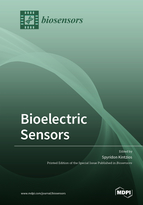Bioelectric Sensors
A special issue of Biosensors (ISSN 2079-6374).
Deadline for manuscript submissions: closed (31 December 2019) | Viewed by 50445
Special Issue Editor
Interests: biosensors; biotechnology; cell culture; cell technology
Special Issues, Collections and Topics in MDPI journals
Special Issue Information
Dear Colleagues,
Bioelectric sensors are unique diagnostic principles and technologies. Although they share many traits with electrochemical sensors, especially regarding the common features of instrumentation, they are focused on the measurement of the electric properties of biorecognition elements as a reflection of cellular, biological, and biomolecular functions in a rapid, very sensitive, and often non-invasive manner. Bioelectric sensors offer a plethora of options in terms both of assay targets (molecules, cells, organs, and organisms) and methodological approaches (e.g., potentiometry, impedance spectrometry, and patch-clamp electrophysiology). Irrespective of the method of choice, “bioelectric profiling” is being rapidly established as a superior concept for a number of applications, including in vitro toxicity, signal transduction, real-time medical diagnostics, environmental risk assessment, and drug development. This Special Issue is the first that is exclusively dedicated to the advanced and emerging concepts and technologies of bioelectric sensors. Topics include, but are not restricted to, bioelectric sensors for single cell analysis, electrophysiological olfactory and volatile organic compounds sensors, impedimetric biosensors, microbial fuel cell biosensors, and implantable autonomous bioelectric micro- and nano-sensors. Also of interest are the innovative approaches offering a high throughput analytical capacity, point-of-care/portable and wireless instrumentation, and intelligent bioelectric sensing platforms. Research papers, short communications, and reviews are all welcome. If the author is interested in submitting a review, it would be helpful to discuss this with the guest-editor before submission.
Prof. Dr. Spyridon Kintzios
Guest Editor
Manuscript Submission Information
Manuscripts should be submitted online at www.mdpi.com by registering and logging in to this website. Once you are registered, click here to go to the submission form. Manuscripts can be submitted until the deadline. All submissions that pass pre-check are peer-reviewed. Accepted papers will be published continuously in the journal (as soon as accepted) and will be listed together on the special issue website. Research articles, review articles as well as short communications are invited. For planned papers, a title and short abstract (about 100 words) can be sent to the Editorial Office for announcement on this website.
Submitted manuscripts should not have been published previously, nor be under consideration for publication elsewhere (except conference proceedings papers). All manuscripts are thoroughly refereed through a single-blind peer-review process. A guide for authors and other relevant information for submission of manuscripts is available on the Instructions for Authors page. Biosensors is an international peer-reviewed open access monthly journal published by MDPI.
Please visit the Instructions for Authors page before submitting a manuscript. The Article Processing Charge (APC) for publication in this open access journal is 2700 CHF (Swiss Francs). Submitted papers should be well formatted and use good English. Authors may use MDPI's English editing service prior to publication or during author revisions.
Keywords
- Bioelectric
- Bioelectric profiling
- Biosensor
- Electrophysiology
- Impedimetric
- Impedance spectrometry
- Implantable
- Medical diagnostics
- Microbial fuel cell
- Microsensors
- Nanosensors
- Olfactory
- Patch-Clamp
- Potentiometry
- Signal transduction
- Single cell analysis
- Vocs
- Toxicology







